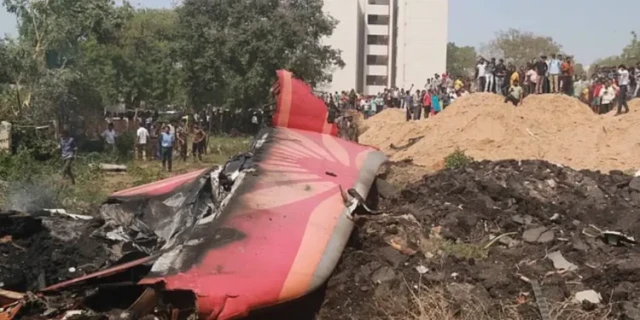AHMEDABAD, India— As the world continues to mourn the tragic loss of 290 lives aboard Air India Flight 171, new and compelling evidence is shifting the narrative around the crash. Investigators are now zeroing in on what aviation experts are calling one of the rarest and most catastrophic failures in modern commercial aviation: the simultaneous loss of both engines.
The UK-bound Boeing 787-8 Dreamliner crashed shortly after takeoff from Ahmedabad on June 12, plunging into a medical college dormitory in a densely populated area. Miraculously, 40-year-old Vishwash Kumar Ramesh survived and was pulled from the wreckage—injured but alive. He remains hospitalized under medical and psychological care, and his harrowing account is helping investigators piece together what went wrong.
A Rare and Chilling Scenario Unfolds
Newly surfaced video footage, reviewed frame-by-frame by aviation analysts, appears to confirm that the aircraft's RAM air turbine (RAT)—a last-resort emergency power system—was deployed in the moments before the crash. The RAT is designed to extend automatically only when both engines fail, providing minimal hydraulic and electrical power to keep essential flight systems operational. The turbine’s distinct whirring sound can also be heard in the final seconds of the recording.
Captain Steve, a respected aviation analyst, confirmed in a recorded commentary that the RAT’s deployment is a strong indicator of complete engine failure. “This is not something you see in typical emergencies,” he stated. “Its activation means both engines lost thrust. It’s a worst-case scenario.”
Ramesh’s own account corroborates the theory. He recalled hearing a loud bang midair, followed by flickering lights and what he described as “a strange silence” before the aircraft nosedived.
Pilot Error, Bird Strike Dismissed
Initial theories included the possibility of a bird strike or pilot misjudgment. But both have now largely been ruled out.
Veteran pilots Captain Sumeet Sabharwal and First Officer Clive Kundar had reported no issues before the final mayday call, which ominously mentioned “loss of thrust.” The aircraft was flying a standard departure profile and was relatively new, fitted with modern avionics and power redundancy systems, including electronic engine controls (EEC) and extensive monitoring sensors.
Related News: UK-Bound Airplane Crash Claims 290 Lives, One Survivor Rescued
Given these facts, experts are now exploring more troubling possibilities: fuel contamination, catastrophic EEC failure, or manufacturing defects—each of which would raise major regulatory concerns for Boeing and the global aviation industry.
Aviation Safety in the Spotlight
The crash has sparked widespread international attention. Victims hailed from multiple countries including India, the United Kingdom, Portugal, and Canada, prompting coordinated investigation efforts among aviation safety boards from each nation.
Independent aviation consultant Meera Khosla emphasized the gravity of the situation. “The Boeing 787 has an exceptional safety record and is certified to continue flying even with a single engine under ETOPS standards,” she said. “For both engines to fail without warning? That demands urgent and exhaustive inquiry. We’re talking about the possibility of a systemic breakdown.”
The Human Story: Survivor’s Guilt and Global Mourning
While forensic teams work around the clock to recover data from the black boxes—Flight Data Recorder (FDR) and Cockpit Voice Recorder (CVR)—the human toll is painfully evident.
Ramesh, the sole survivor, had been returning to the UK after a brief visit to India. He now faces the daunting emotional aftermath of being the only person to survive what has been described as an “unimaginable catastrophe.” Mental health professionals say he is likely experiencing , survivor’s guilt—a psychological condition marked by feelings of undeserved survival, depression, nightmares, and anxiety.
“His journey to recovery will be long and painful,” said trauma therapist Dr. Anjali Bhatt. “But with time, counseling, and the right support systems, many survivors do find meaning and healing after such unimaginable events.”
Next Steps: The Investigation Unfolds
Authorities have laid out a roadmap for the next phase of the investigation:
Recovery and analysis of the FDR and CVR, which are expected to provide crucial insight into what happened in the cockpit and to the aircraft systems in the final moments.
Cross-referencing the mayday call with radar and ATC (Air Traffic Control) data to create a precise timeline of the flight’s final trajectory.
Comprehensive inspection of the aircraft’s fuel systems, electronic engine control units, and maintenance records for possible signs of contamination or system failure.
While investigators stress the need for a thorough and impartial process, pressure is mounting—from victims' families, airline regulators, and the global flying public—for swift answers and systemic reforms.
A Community and Industry in Mourning
Air India has expressed condolences and promised full cooperation with the investigation, though public trust remains shaken. Boeing, already under scrutiny from past incidents involving the 737 MAX series, now faces renewed questions about quality assurance and engine design standards across its fleet.
For now, the skies remain a little heavier.
As the investigation continues and the world watches, the families of 290 victims—and the one man who lived—wait for answers. Answers that may one day provide accountability, closure, and the assurance that what happened aboard Flight 171 will never happen again.




















